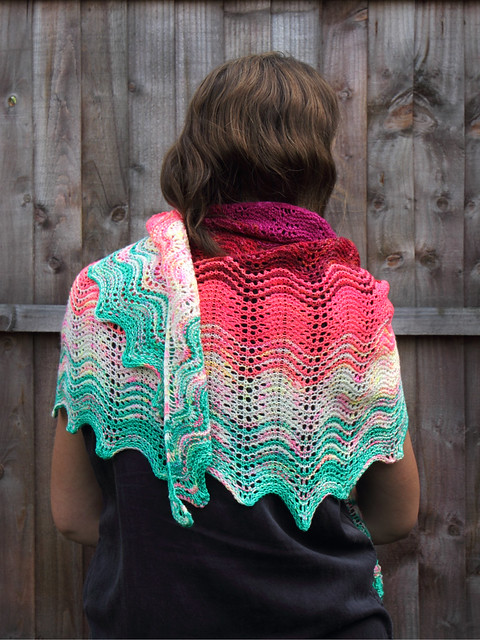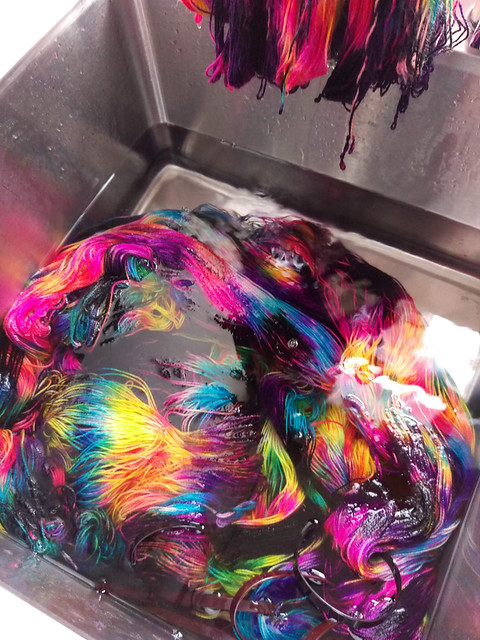Neon colours are an important part of my aesthetic as a dyer (as if you hadn’t noticed). Of course, a large component of my colour choices is shades and combinations that I personally like, and neon colours most definitely fall into that category.

Shawl using 4 of our neon yarn shades alongside regular colours. Pattern: Blend In, Stand Out by Brixton Purl
However, it goes deeper than that. When I launched my dye business I wanted to challenge the cultural perceptions of textile crafts that I constantly encountered. I don’t believe that textiles have to be traditional or in muted, neutral tones to be worthy as artistry (although I like neutrals too). Equally, I want to show that being bold, brash or contemporary doesn’t make a creation trashy or throw-away or poor quality. It is such a nice thing when seeing a vibrant skein inspires someone to have a go when they didn’t previously associate their identity with crafts.
What are neon colours?
Neon (or more correctly, fluorescent) pigments have a very special property that makes them appear brighter than their surroundings by reflecting more light than conventional colours, this is called photoluminescence. How does this work? These pigment have molecules that can absorb the energy from light in the invisible UV part of the spectrum and reemit that energy as light with a higher wavelength in the visible spectrum.
The more UV light present, the brighter the colour will appear. Some of the modern, energy efficient lighting in our homes doesn’t emit much UV so the effect is reduced. In natural light, the percentage of UV increases at dusk, so the effect is enhanced, and of course, under a UV lamp it positively lights up.
How do you create neon yarn colours?
It is most fortunate that a few fluorescent pigments exist that can be used as acid dyes, suitable for dyeing wool and protein fibres. Believe it or not, we only have two neon dyes – a yellow and a pink. By mixing these together and with (non-neon) turquoise we’re able to create a full spectrum of neon colours.

Our ‘Glow Sticks’ shade created using a dip-dye technique with three colours (neon yellow, neon pink and turquoise)
Do neon dyes just like normal dyes?
Being acid dyes they are different from the majority of the pigments we use, which are on the ‘reactive dyes’ family, although on wool they processes are broadly the same. However, they are very temperamental. They ‘strike’ (react with the yarn) at quite a narrow temperature range (typically very hot) and they take nearly twice as long to fix. The pink likes it very acidic, and the yellow is so sensitive to impurities in the water we have to descale our water heater before mixing it into solution, and filter the dye solution. They are roughly twice as concentrated as most dyes so a little goes a long way. We have to adapt our processes when working with neons, they are difficult but worth it.
Are they safe?
It might surprise you that the two neons we use are among the safest dye pigments out there. They are non-toxic and some of their recommended uses as colourings for soaps, household cleaning products and environmental applications such as tracing agents for waterways. We source all our dyes from UK regulated suppliers in order to ensure that they meet the UK’s strict environmental and safety standards. It’s often cheaper to import, but when sourcing from the US for example, it is possible to buy dyes containing toxic heavy metals which are not approved for use here.
Caring for garments made with neon yarns
Just as these colours are a little trickier for us to work with in the studio, they do require special care to keep them looking their best. They are not as colour fast as normal dyes but our care recommendations are quite simple: hand wash cold. We really do mean cold, not tepid or lukewarm. After handwashing, it’s fine to spin them in a machine to get the excess water out and dry flat as normal.
We do not recommend leave-in wool washes (e.g. Soak), they have a lower pH than normal detergent that can cause the neon pigments to bleed. We do recommend rinsing and not leaving your garments to soak for too long. We use Ecover Delicates detergent, which is suitable for wool and silk. More care tips
The most important rule of all when working with neons: HAVE FUN!
